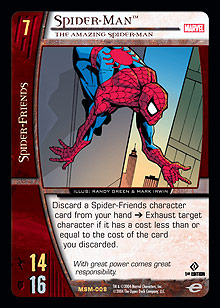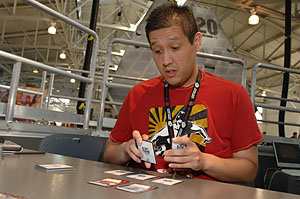
Part 1
Getting up at 5:30 on the morning of the Pro Circuit has become a bit of a tradition for me. I’d like to be able to say that it is part of my meticulous pre-tournament preparation regime, but it has far more to do with jetlag and adrenaline.
I grab a shower and write out my decklist while my Canadian roommates sleep on. I do my best not to wake them prematurely, but gamer hotel rooms aren’t the tidiest of places and I’ve noisily tripped over things in the dark a few times over the years. At least nobody has to worry about oversleeping.
Breakfast is a controversial subject among gamers. Some will stock up on food for the day, while others stick to something light and easily digested. I go even further and stick to sugary drinks until we’re done for the day; my body has never coped well with the stress of big events and I find that this makes it a little easier.
With breakfast dealt with, we walk down to the tournament venue as a team. The conversation is light and keeps well away from the subject of cards as everybody tries to keep their heads clear for the big event.
 The first round is always a nervous affair, and I’m paired with Florian Hess, who has a fairly classic Good Guys build. I haven’t tested much against Good Guys, but I know that the plan against all stunted curve decks is to abuse Merlyn and drag the game out so that Spider-Man, The Amazing Spider-Man can shut down opposing attacks from turn 7 on.
The first round is always a nervous affair, and I’m paired with Florian Hess, who has a fairly classic Good Guys build. I haven’t tested much against Good Guys, but I know that the plan against all stunted curve decks is to abuse Merlyn and drag the game out so that Spider-Man, The Amazing Spider-Man can shut down opposing attacks from turn 7 on.
Florian has an unfortunate draw. He misses his 1-drop and under-drops with Sue Dibny on turn 2. After that, the game plan kicks in and extra damage from Fire, Beatriz DaCosta isn’t quite enough for Florian. I’m 1-0 and the nerves begin to settle.
Round 1 went well for the team as a whole. Our spirits are lifted by each other’s success and the knowledge that Deep Green is looking like a good deck choice.
In round 2, I’m up against Eric Berg and a classic G’Lock build. On turn 1, he makes Sonar to my no recruit and takes the early lead. Turns 2 and 3 are on plan for both of us with my recruits of Talia and Samsarra (concealed) to Eric’s Kyle Rayner and Dr. Light.
On turn 4, the game takes a dramatic shift. Worried about Leech (a Morlock who can shut down Merlyn), I make Fatality, Flawless Victory instead. Eric under-drops, and after three attacks and a Mikado, he is going into turn 5 with no characters.
On turn 5, I make Annihilation Protocol ◊ OMAC Robot and end up using his ability to KO Katma Tui. On turn 6, Eric concedes with me on 49 endurance (so close to a flawless victory!). He was a little unlucky, but this is a matchup that Deep Green should never lose. I progress to 2-0.
Round 3 is Olav Rokne in what is effectively a card-for-card mirror match. The bragging rights alone would ensure a competitive game. I’ve been friends with Olav since we met at a gaming convention in 1999, but this is the first time we’ve played a competitive game.
The first four turns are perfect symmetry as we both make Talia, Samsarra, and Merlyn. We both use Merlyn to force a Science Spire retreat from Samsarra, and we go into turn 5 all square. I have the initiative on turn 5 and am happy to make the Annihilation Protocol in my hand. Meanwhile, Olav searches out Maxwell Lord, Black King so that he can discard a location to shut down Merlyn’s ability before my attack step begins.
I’m able to attack down the curve into Merlyn and end up going into turn 6 with a slight advantage. The pure mirror match is probably the only one where you want the odd initiative. By turn 7, I’ve got both my 7-drops and Slaughter Swamp, and Olav is missing the Spider-Man who is vital in the painfully slow mirror match. I’m now 3-0 and it feels just like playing Titans in the unprepared field of the very first Pro Circuit.
Round 4 is another familiar name, Jonas Skali, and my second match against Good Guys. One of the problems with playing the ally-based deck is that you can run out of cards in hand quickly, but Jonas makes it clear that isn’t going to be a problem with a turn 2 Straight to the Grave for Mr. Mxyzptlk, Troublesome Trickster.
The game is looking close on turn 4. Merlyn takes out the 3-drop and Samsarra attacks up the curve—a fairly common play. Jonas’s eyes light up with the stunned King on the board, knowing that all he needs to do is KO him for the win. He uses Kooey Kooey Kooey to search out Chopping Block and discards it along with two other cards to remove Samsarra from the game.
Samsarra is removed from play, so he never hits the KO’d pile, and Jonas is now a resource down. The game is still close because I’m unable to search for locations, but soon I find myself at 4-0. Jonas finished 24th in a Pro Circuit where he still needed to read a lot of the cards, so don’t be too surprised if he starts making Top 8s very soon.
 It’s round 5 and I’m playing “some guy” called Karl Horn. Any doubt about what he’s playing is soon removed when Hope, Amazon Bodyguard hits the table on turn 1; this is the infamous Ivy League discard deck, and in Karl’s hands, it’s going to be a real threat.
It’s round 5 and I’m playing “some guy” called Karl Horn. Any doubt about what he’s playing is soon removed when Hope, Amazon Bodyguard hits the table on turn 1; this is the infamous Ivy League discard deck, and in Karl’s hands, it’s going to be a real threat.
On turn 2, I trade my 2-drop with Poison Ivy and then use Mikado to stun Hope. This looks card neutral, as Hope’s job is to turn Justice League of Arkham face down to force another discard and I’d discarded a card to get rid of her, but it removed a team affiliation from the table, and that can have unexpected benefits further down the line.
On turn 3, Sage, Xavier’s Secret Weapon comes out, and Karl’s life suddenly gets rather complicated. Ivy League has to get rid of her, and the easiest way is to reach ten cards in the discard pile and then use Deadshot, Floyd Lawton to KO her . . . but finding the most efficient way to do this takes some doing.
By this point in the tournament, several Checkmate players have already lost to Deadshot KO’ing Samsarra, so I am very reluctant to play Samsarra turn 4. But I have nothing else to play, so he comes down anyway. It isn’t clear whether Samsarra will get to do much or whether he’ll spend most of his time setting up The Science Spire that will allow him to escape.
Turn 5 is very slow, as Karl has a lot of decisions to make and I have to make sure he isn’t creating a situation where Samsarra can’t escape and that I need to interrupt. Time is called about two minutes before we reach the end of turn 5, which ends with Karl on just 10 endurance. With Samsarra safely returned to hand (before being discarded along with the rest of my hand), it looks very likely that I’ll either finish things off or win on time.
At the start of turn 6, I point out that this is our final turn. I can’t emphasize enough how important it is to communicate clearly with your opponent; you’re both responsible for maintaining the game state, and the only way to do that is to make sure that you both know what it is at all times.
With two 4-drops in hand, I choose not to place a sixth resource and to play the OMAC Robot. From Karl’s reaction, I’m guessing that he has one more Justice League in his row, and not making the resource is the only reason I got to make a character this turn. Karl is understandably disappointed to lose on time and I progress to 5-0.
Halfway through the day, it’s quite clear which players have been playing Deep Green for the last month and which have switched at the last minute because they thought the metagame was unfavorable to their preferred deck. The daft thing is that the metagame didn’t end up all that unfavorable for them, after all. Maybe we should all ignore the last minute meta-calling and just play the deck we’re most comfortable with; that’d make life really tough for those who earn their living by calling the metagame correctly every time.
Ian “Picked His Deck a Month Before the PC” Vincent